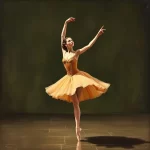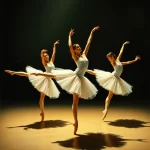Ballet: Manon (Jules Massenet, 1974)

Introduction
Ballet: Manon, choreographed by Sir Kenneth MacMillan and set to the music of Jules Massenet, premiered in 1974. This ballet, based on the 1731 novel “Manon Lescaut” by Abbé Prévost, tells the tragic love story of Manon and Des Grieux. The ballet is renowned for its emotional depth, complex characters, and the seamless integration of Massenet’s music with MacMillan’s choreography.
Historical Background
Creation and Development
The creation of Ballet: Manon occurred during a period of significant artistic exploration in the 1970s. The era was marked by a blend of traditional and contemporary influences in the arts. Sir Kenneth MacMillan, a prominent figure in the ballet world, sought to push the boundaries of classical ballet by incorporating intense emotional narratives and complex character development.
MacMillan drew inspiration from Abbé Prévost’s novel “Manon Lescaut,” a story that had already inspired operas by composers like Giacomo Puccini and Jules Massenet. The collaboration between MacMillan and Massenet’s music, although the latter had passed away long before the ballet’s creation, was facilitated by the careful selection and arrangement of Massenet’s compositions to suit the ballet’s narrative.
Premiere and Reception
Ballet: Manon premiered on March 7, 1974, at the Royal Opera House in London. The initial reception was mixed, with some critics praising the ballet’s emotional intensity and others questioning its departure from traditional ballet themes. However, the audience response was overwhelmingly positive, and the ballet quickly gained popularity.
Notable early performances included those by renowned dancers such as Antoinette Sibley and Anthony Dowell, whose portrayals of Manon and Des Grieux set a high standard for future interpretations. The ballet has since been revived numerous times, becoming a staple in the repertoires of major ballet companies worldwide.
Synopsis of the Ballet
Act I Summary
The ballet opens in a bustling courtyard in Paris, where we are introduced to the young and beautiful Manon, who is on her way to a convent. She meets the handsome student Des Grieux, and they quickly fall in love. Manon’s brother, Lescaut, has other plans for her, intending to sell her to the wealthy Monsieur GM. Despite this, Manon and Des Grieux run away together to Paris.
Act II Summary
In Paris, Manon and Des Grieux live together in blissful poverty. However, their happiness is short-lived as Lescaut and Monsieur GM find them. Manon is tempted by the promise of wealth and luxury and leaves Des Grieux to become Monsieur GM’s mistress. Des Grieux is heartbroken but remains devoted to Manon.
Act III Summary
Manon’s life with Monsieur GM is one of opulence but also emptiness. She realizes her mistake and reunites with Des Grieux. They attempt to escape together, but their plan is thwarted. Manon is arrested and deported to Louisiana as a convict. Des Grieux follows her, and in the final, tragic scene, Manon dies in his arms, exhausted and broken by their ordeal.
Finale
The conclusion of Ballet: Manon is both heartbreaking and poignant. Manon’s death in Des Grieux’s arms signifies the ultimate sacrifice for love and the tragic consequences of her choices. The finale leaves a lasting impression on the audience, highlighting the themes of love, betrayal, and redemption.
Musical Composition
Composer’s Role
Jules Massenet, a French composer known for his operas, provided the music for Ballet: Manon. Although Massenet did not compose the music specifically for the ballet, MacMillan selected and arranged pieces from Massenet’s existing works to create a cohesive score. This approach allowed the music to enhance the narrative and emotional depth of the ballet.
Musical Themes and Motifs
The music of Ballet: Manon features recurring themes and motifs that underscore the characters’ emotions and the story’s dramatic arc. For example, Manon’s theme is often light and playful, reflecting her youthful innocence, while Des Grieux’s theme is more passionate and intense, mirroring his deep love for Manon. The music’s ability to convey the characters’ inner turmoil and the story’s tragic elements is a testament to Massenet’s compositional genius.
Famous Recordings and Performances
Several recordings of Ballet: Manon’s music have been made, capturing the beauty and emotional depth of Massenet’s compositions. Notable performances include those by the Royal Ballet, with renowned conductors such as Richard Bonynge and Barry Wordsworth leading the orchestra. These recordings have helped to cement the ballet’s place in the classical repertoire.
Choreography and Dance
Choreographer’s Vision
Sir Kenneth MacMillan’s vision for Ballet: Manon was to create a ballet that combined classical technique with intense emotional storytelling. His choreography is known for its dramatic expressiveness and the way it pushes dancers to convey complex emotions through movement. MacMillan’s innovative approach to choreography has made Ballet: Manon a landmark work in the ballet world.
Signature Dance Numbers
One of the most iconic dance numbers in Ballet: Manon is the Pas de Deux between Manon and Des Grieux in Act II. This dance is a powerful expression of their love and longing, characterized by intricate lifts and passionate movements. Another notable scene is Manon’s solo in Act III, where she reflects on her life and choices, showcasing her emotional turmoil and vulnerability.
Notable Interpretations
Over the years, different productions of Ballet: Manon have brought unique interpretations to the choreography. Some have emphasized the ballet’s romantic elements, while others have focused on its darker, more tragic aspects. Notable dancers such as Sylvie Guillem, Alina Cojocaru, and Roberto Bolle have brought their own interpretations to the roles of Manon and Des Grieux, each adding new dimensions to the characters.
Characters and Roles
Main Characters
- Manon: A young woman torn between love and the allure of wealth. Her character is complex, embodying both innocence and ambition.
- Des Grieux: A passionate and devoted student who falls deeply in love with Manon. His character represents unwavering love and loyalty.
- Lescaut: Manon’s brother, who is more concerned with financial gain than his sister’s happiness. He plays a pivotal role in Manon’s fate.
- Monsieur GM: A wealthy and manipulative man who seeks to possess Manon. He represents the corrupting influence of wealth and power.
Supporting Characters
- Old Man: A minor character who adds to the atmosphere of the Parisian setting.
- Courtesans and Gentlemen: These characters populate the world of wealth and decadence that Manon becomes a part of.
Famous Dancers
Many renowned dancers have portrayed the roles in Ballet: Manon. Antoinette Sibley and Anthony Dowell were among the first to bring Manon and Des Grieux to life. Other notable dancers include Sylvie Guillem, Alina Cojocaru, Roberto Bolle, and Carlos Acosta, each bringing their own unique interpretations to these iconic roles.
Cultural and Artistic Impact
Influence on Ballet and Dance
Ballet: Manon has had a significant influence on the world of ballet and dance. Its blend of classical technique and emotional storytelling has inspired other choreographers to explore similar themes. The ballet’s success has also contributed to the continued popularity of narrative ballets in the modern repertoire.
Cultural Significance
The ballet’s themes of love, betrayal, and redemption resonate with audiences across different cultures and time periods. Ballet: Manon has been adapted into various forms, including film and theater, further cementing its place in popular culture. Its enduring appeal lies in its ability to connect with audiences on a deeply emotional level.
Legacy and Revivals
Ballet: Manon continues to be performed and celebrated today. Major ballet companies around the world regularly include it in their repertoires, and it has been the subject of numerous revivals and reinterpretations. The ballet’s legacy is a testament to its timeless appeal and the enduring power of its story and music.
Iconic Productions
Historic Productions
One of the most famous historical productions of Ballet: Manon was the original 1974 premiere at the Royal Opera House. This production featured Antoinette Sibley and Anthony Dowell in the lead roles, with Kenneth MacMillan’s groundbreaking choreography setting a new standard for narrative ballets.
Contemporary Productions
Recent productions of Ballet: Manon have brought fresh perspectives to the ballet while staying true to MacMillan’s original vision. Companies such as the Royal Ballet, the Paris Opera Ballet, and the American Ballet Theatre have all staged successful productions, each adding their own unique touches to the choreography and design.
Production Design
The production design of Ballet: Manon plays a crucial role in bringing the story to life. Set and costume designers have created elaborate and evocative designs that capture the opulence of 18th-century Paris and the starkness of Manon’s final moments. Lighting design also plays a key role in setting the mood and enhancing the emotional impact of the ballet.
Critical Reception and Reviews
Initial Critical Response
The initial critical response to Ballet: Manon was mixed, with some critics praising its emotional depth and others questioning its departure from traditional ballet themes. However, the ballet quickly gained a following among audiences, and its popularity grew with each subsequent performance.
Modern Reviews
Contemporary critics and audiences continue to hold Ballet: Manon in high regard. The ballet is praised for its powerful storytelling, complex characters, and the seamless integration of Massenet’s music with MacMillan’s choreography. Its enduring relevance is a testament to its timeless themes and emotional resonance.
Fun Facts and Trivia
Behind-the-Scenes Stories
One interesting behind-the-scenes story involves the creation of the Pas de Deux in Act II. MacMillan worked closely with the dancers to develop the choreography, drawing on their strengths and abilities to create a dance that was both technically challenging and emotionally powerful.
Notable Performers
Many famous dancers have been associated with Ballet: Manon over the years. In addition to Antoinette Sibley and Anthony Dowell, other notable performers include Sylvie Guillem, Alina Cojocaru, Roberto Bolle, and Carlos Acosta. Each of these dancers has brought their own unique interpretations to the roles, adding to the ballet’s rich performance history.
Trivia
- Ballet: Manon is one of the few ballets based on a novel rather than a fairy tale or myth.
- The ballet’s music is not a single composition but a carefully curated selection of pieces from Massenet’s existing works.
- Sir Kenneth MacMillan was known for his innovative and often controversial approach to choreography, and Ballet: Manon is considered one of his masterpieces.
Conclusion
Summary of the Ballet’s Importance
Ballet: Manon is a significant work in the world of dance, known for its emotional depth, complex characters, and innovative choreography. The collaboration between Sir Kenneth MacMillan and Jules Massenet’s music has created a ballet that continues to captivate audiences and inspire dancers and choreographers alike.
Final Thoughts
Ballet: Manon is a testament to the power of storytelling through dance. Its themes of love, betrayal, and redemption resonate with audiences across different cultures and time periods. Whether you are a seasoned ballet enthusiast or new to the art form, Ballet: Manon is a must-see performance that will leave a lasting impression.
FAQ
What is the central theme of this ballet?
The central theme of Ballet: Manon is the tragic love story between Manon and Des Grieux, exploring themes of love, betrayal, and redemption.
Who are the main characters in this ballet?
The main characters are Manon, Des Grieux, Lescaut (Manon’s brother), and Monsieur GM (a wealthy suitor).
What is the most famous dance number in this ballet?
The Pas de Deux between Manon and Des Grieux in Act II is one of the most famous and iconic dance numbers in Ballet: Manon.
How long does a typical performance of this ballet last?
A typical performance of Ballet: Manon lasts approximately two hours, including intermissions.
Are there any modern adaptations of this ballet?
Yes, Ballet: Manon has been adapted into various forms, including film and theater, and continues to be performed by major ballet companies worldwide.
Why is this ballet considered important in the history of dance?
Ballet: Manon is considered important for its innovative choreography, emotional depth, and the seamless integration of Massenet’s music with MacMillan’s storytelling. It has had a significant influence on the development of narrative ballets and continues to inspire dancers and choreographers today.





